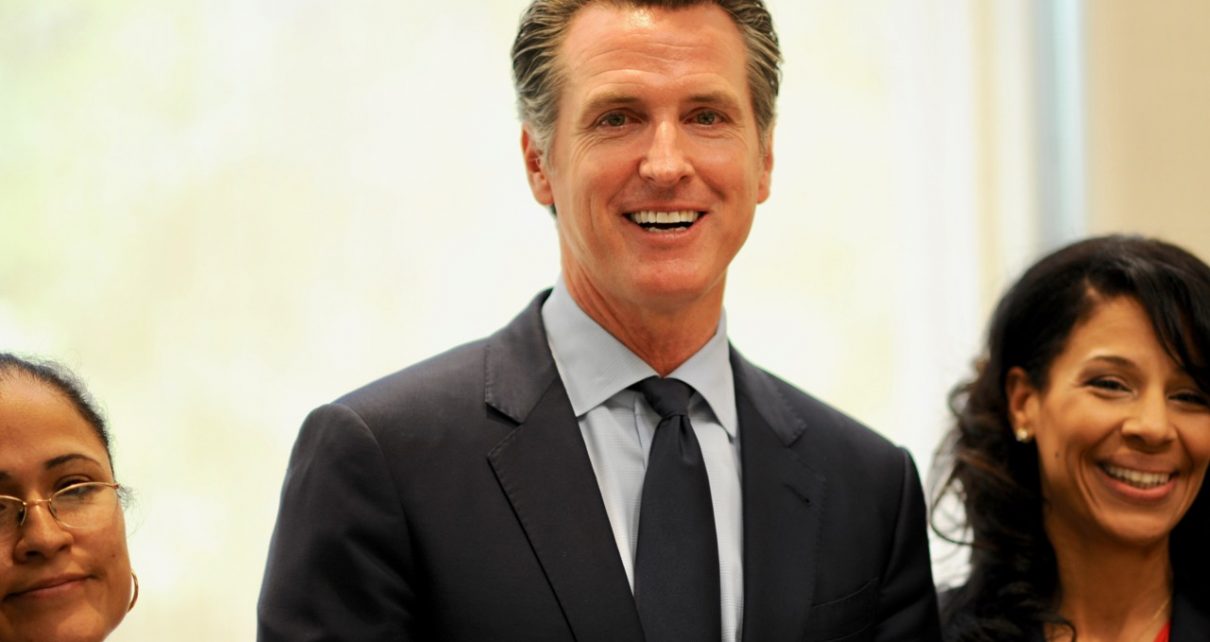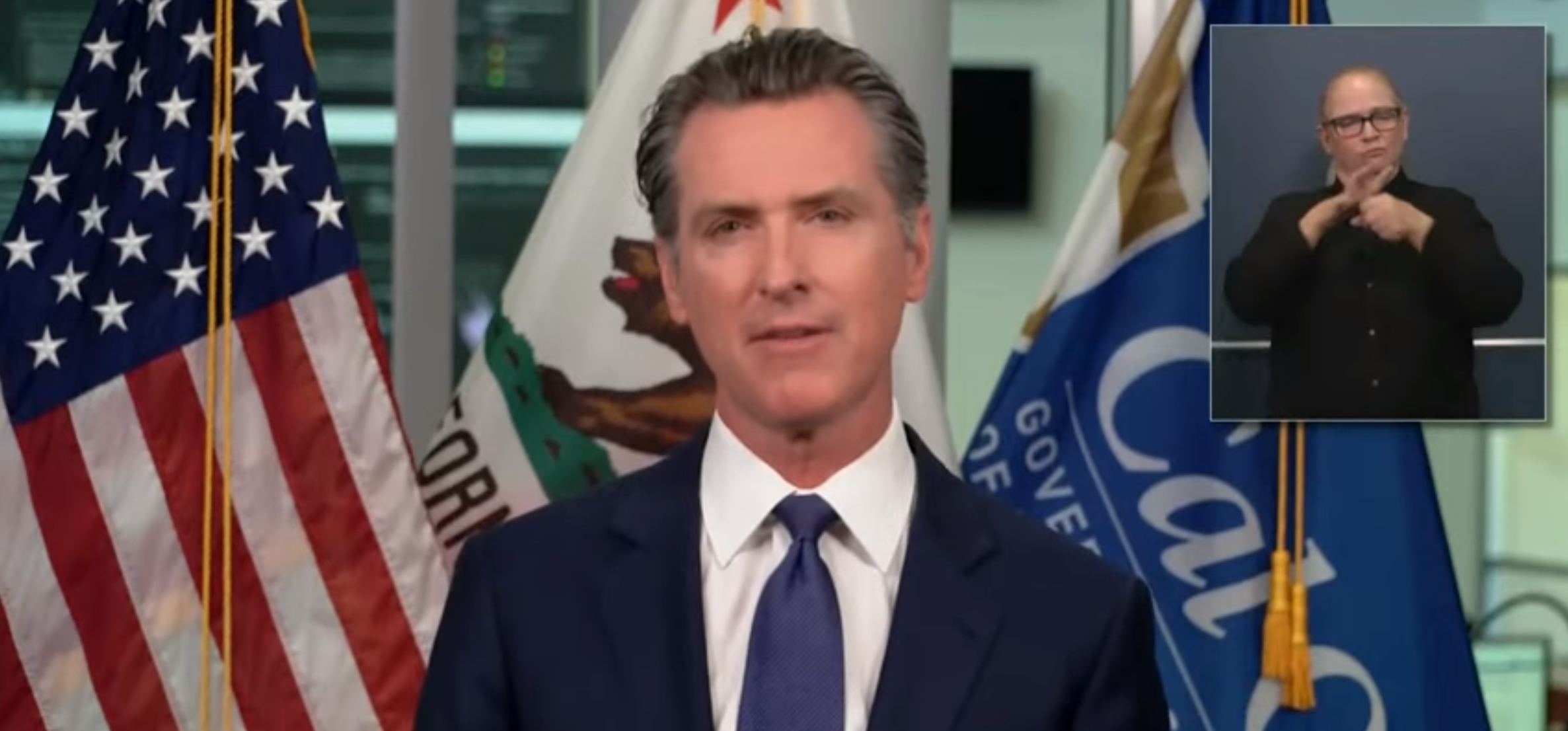
Governor Gavin Newsom. (Photo: Kevin Sanders for California Globe)
Governor Newsom Gets Most of What He Wants in 2019-20 Budget
Largest budget in California history grants health care to illegal immigrants
By Katy Grimes, June 28, 2019 7:25 am
The largest budget in California history was just signed Thursday evening by Gov. Gavin Newsom. The $214.8 billion budget bill agreed to by lawmakers, includes more than 25 “trailer bills” full of spending and issues that did not go through the committee process, or did, and were killed, so they were added in the back end of the budget. Gov. Newsom will address the trailer bills in the next weeks.
A majority of Newsom’s budget proposals were issues lawmakers had tried to pass in previous years but were vetoed by former Gov. Jerry Brown including providing health coverage to illegal aliens up to age 26, certain housing mandates, and mandatory preschool.
Days before signing the budget, Gov. Newsom posted this odd video on Twitter telling illegal aliens how to avoid ICE officials, letting them know they have sanctuary in California. And then he signed the budget bill granting Medi-Cal health care benefits to illegal aliens aged 19-26.
Newsom also brought back the “Individual Mandate” to require Californians to purchase health insurance, and imposes a $695 fine for failure to do so.
CA will always defend the rights of our immigrant communities.
If ICE agents show up at your door, know your rights:
-You do not have to open the door—you have the right against unlawful searches.
-You have the right to speak to a lawyer.
-You have the right to remain silent. pic.twitter.com/wNokTSPdhD
— Gavin Newsom (@GavinNewsom) June 22, 2019
Gov. Newsom’s office presented Significant details of the 2019-20 budget:
Building a Strong Fiscal Foundation
The Budget will end the year with total reserves of $19.2 billion, of which $16.5 billion is in the Rainy Day Fund, $1.4 billion in the Special Fund for Economic Uncertainties, $900 million in the Safety Net Reserve, and nearly $400 million in the Public School System Stabilization Account.
The Budget makes an extra payment of $9 billion over the next four years to pay down unfunded pension liabilities. This includes $3 billion to CalPERS and $2.9 billion to CalSTRS on behalf of the state, and $3.15 billion to CalSTRS and CalPERS on behalf of schools.
The Budget invests $4.5 billion to eliminate the Wall of Debt and reverses the decade old deferral undertaken during the last recession.
The Budget prioritizes one-time investments, with 88 percent of new expenditures being temporary rather than ongoing. This addresses the affordability crisis facing Californians while minimizing ongoing commitments to avoid putting the state at fiscal disadvantage in the future.
Confronting the Cost Crisis
The Budget tackles affordability challenges and expands opportunity for all Californians. The Budget supports Californians facing the cost crisis by expanding health care access, increasing housing production, making historic investments in education, expanding the Cal-EITC Working Families Tax Credit and investing in early childhood education and development.
Health Care
The Budget preserves health coverage protections for Californians and includes a series of proposals that leads the nation in reducing health care costs and increasing access for families. The Budget:
- Invests $1.45 billion over three years to increase Covered California health insurance premium support for low-income Californians – and provides premium support for the first time to qualified middle-income individuals earning up to $72,000 and families of four earning up to $150,000, partially funded by restoration of an enforceable Individual Mandate
- Expands Medi-Cal coverage to all income-eligible undocumented young adults ages 19 through 25
- Includes an increase of $1 billion, using Prop 56 funding, to support increased rates to Medi-Cal providers, expanded family planning services, and value-based payments that encourage more effective treatment of patients with chronic conditions
- Invests in and supports California’s seniors by expanding health and other vital state services to this fast-growing part of California’s population
- Ends the “senior penalty” in Medi-Cal by raising the income eligibility limit for older Californians
- Expands eligibility to 138 percent of the federal poverty level for the Medi-Cal Aged, Blind and Disabled program, estimated to help 22,000 Californians
- Invests boldly in responding to Alzheimer’s disease including $3 million for research grants with a focus on women and communities of color, and $5 million for Alzheimer’s disease local infrastructure
- Establishes a pathway to transition Medi-Cal’s drug benefit to a model where the state is directly bargaining for the lowest drug prices
- Restores the 7 percent across the board reduction to IHSS service hours
Housing Affordability
The high cost of housing is a defining quality-of-life concern for people across California. In order to increase housing supply, the Budget makes a historic investment to accelerate the production of new housing, and supports local governments to meet their required housing goals.
- The Budget invests $1.75 billion in the production and planning of new housing. It includes support to local governments to increase housing production
- The Governor has taken measures to hold local jurisdictions accountable to meet housing demand
- To assist renters, the Budget includes $20 million to provide legal aid for renters and assist with landlord-tenant disputes, including legal assistance for counseling, renter education programs, and preventing evictions
Working Families Tax Cut
The Cal-EITC has helped put money back into the pockets of California’s working families, lifting some out of poverty. The Budget more than doubles the investment in the Cal-EITC to $1 billion, which will increase the number of participating households from 2 million to 3 million and:
- Help low-income families with young children through a new $1,000 credit for families with children under the age of six
- Significantly increase the average yearly amount individuals receive through the tax credit
- Expand eligibility to include full-time workers making the 2022 minimum wage of $15/hour
Parents Agenda
The Budget includes a Parents Agenda that addresses specific cost-of-living issues faced by young parents and parents of small children. The Budget:
- Expands paid family leave from six to eight weeks for each parent or caretaker of a newborn child, potentially allowing a child to benefit from as much as four months of paid family leave. This will bring California closer to the goal of six months of paid family leave, helping more workers, especially lower-wage workers, who pay into the system take the benefits
- Puts California on the path to provide universal access to preschool for all four-year olds and full-day kindergarten, including funding for childcare workers, expanding state-subsidized facilities and increasing slots
- Provides resources for lower-income parents, including: home-visiting services, black infant health programs, developmental and trauma screenings, temporary cash assistance to families with children to meet basic needs, child savings accounts to support future higher education expenses and a sales tax exemption on diapers and menstrual products
- Establishes or increases Cal Grant Access Awards for student parents attending the University of California, California State University, or California Community Colleges. This two-generation approach will help students complete their education, increase their future earning potential, and provide additional support to their children
Education
The Budget makes an historic investment in education for Californians, paving the path towards universal preschool, recruiting and retaining qualified educators and facilitating tuition freezes at the UC and CSU.
K-14
- Makes highest-ever investment in K-14 education, including approximately $5,000 more per K-12 pupil than eight years ago
- Invests $90 million to recruit and retain qualified educators to teach in a high-need field at priority schools and address California’s teacher shortage, and invests $43.8 million to provide training and resources for classroom teachers and paraprofessionals to build capacity around key state priorities
- Supports students with specialized needs by providing a 19.3-percent increase in funding for special education
Higher Ed
- Significantly increases funding for higher education, facilitating tuition freezes and increased enrollment slots at both the University of California and California State University systems for the 2019-20 school year
- Provides support for community college students by funding two years of free community college tuition for first-time, full-time students
- Provides $41.8 million to increase the number of competitive Cal Grant scholarships from 25,750 to 41,000 for income-eligible Californians
- Provides $96.7 million to support the living expenses of student parents with dependent children to increase degree completion
- Qualifying new or renewal Cal Grant A recipients will receive an access award of up to $6,000,
- Qualifying new or renewal Cal Grant B recipients will see their access award increase from $1,648 to $6,000, and
- Qualifying Cal Grant C recipients will see their book and supply award increase from $1,094 to $4,000
- Provides $50 million for child savings accounts that aid families in managing future higher education expenses
Preparing For Emergencies
Climate change has created a new reality that impacts every Californian, in urban, suburban and rural communities. Governor Newsom is taking aggressive actions to build resiliency, increase response and tackle recovery. The Budget invests nearly $1 billion:
- Includes $225.8 million to implement forest health and wildfire prevention efforts
- Builds resilience to ensure every community is prepared in the face of a disaster with investments in community emergency preparedness, 9-1-1 system upgrades and earthquake warning system development
- Funds new firefighting resources and technology so Cal FIRE has state-of-the-art tools at its disposal when responding to disasters, including:
- $127.2 million for C-130 Air Tankers and twenty-first century firefighting helicopters
- $130.3 million for better communication equipment for first responders
- Supporting communities so they can get back on their feet after a disaster, including investment in local property tax backfill, Camp Fire Recovery and the California Disaster Assistance Act
Advancing Justice for All
Homelessness
California is facing a homelessness epidemic across the state. Recognizing the importance of mental health supports in the fight against homelessness, the Budget includes an historic $1 billion investment, which will:
- Provide homelessness emergency aid to local governments for emergency housing vouchers, rapid rehousing programs and emergency shelter construction
- Increase mental health supports, which includes expanding Whole Person Care services that provide wrap-around health, behavioral health and housing services, and building strategies to address the shortage of mental health professionals in the public mental health system
- Fund rapid rehousing and basic needs initiatives for students in the University of California, California State University and California Community College systems
Safe Drinking Water
The Budget provides stable ongoing funding to assist disadvantaged communities in paying for the costs of obtaining access to safe and affordable drinking water. The proposal will:
- Initiate the Safe and Affordable Drinking Water Fund program one year earlier than previously planned by investing $100 million Greenhouse Gas Reduction Funds (GGRF) and $30 million General Fund in 2019-20; with $130 million continuously appropriated on an ongoing basis until 2030
- Use the GGRF for safe drinking water to advance the state’s climate resiliency goals by helping to secure water resources statewide and advance the state’s climate change priorities by supporting and providing benefits to disadvantaged communities most impacted by climate change
Criminal Justice
The Budget prioritizes public safety, while helping to make the state’s criminal system more humane and just – focusing on rehabilitation and successful reentry.
- Moves youth correctional facilities from the California Department of Corrections and Rehabilitation to a new department under the Health and Human Services Agency to enable the state to better provide youth offenders with services and support reentry
- Provides local law enforcement training on use of force and de-escalation, while restoring funding to maintain training and improve competency for local correctional and law enforcement personnel
- Overhauls the substance use disorder programs in prison, including integrating medically assisted treatment and reentry services as appropriate
California Globe will take a deep analytical dive into the budget as trailer bills are signed.
- Merry Christmas from Trump: US Economy Unexpectedly Surges 4.3% in Third Quarter — Strongest Growth in Two Years - December 23, 2025
- Leaving California: Three More Major Businesses Close or Move Out of State - December 22, 2025
- Gov. Gavin Newsom’s ‘Great Leap Forward’ – DEI and Reparations Agriculture Land Seizure Scheme - December 22, 2025





What a surprise, this carpetbagger pretty boy got everything he wanted – when you have a super majority, you can do whatever you want! At this point in time, the dems in Sacramento think they have all the cards. Their time will come, someone has already started a recall petition on NewScum.